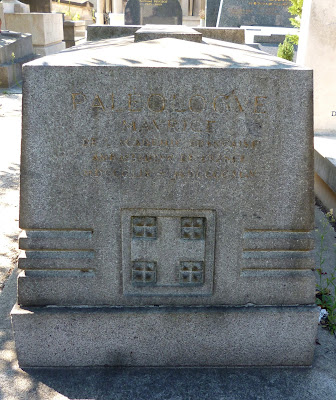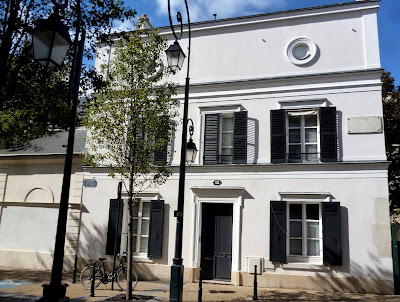'LE POÈTE
THÉOPHILE GAUTIER
NÉ À TARBES LE 31 AOÛT 1811
EST MORT DANS CETTE MAISON
LE 23 OCTOBRE 1872'
'Maison de Théophile Gautier
En 1857, quittant la rue de la Grange-Batelière à Paris, l'écrivain Théophile Gautier (Tarbes, 1811 – Neuilly-sur-Seine, 1872) s'installe au 32, rue de Longchamp, sur les conseils des directeurs du Moniteur universel, journal dont il est l'un des principaux collaborateurs.
Avec sa compagne, Ernesta Grisi, cantatrice d'origine italienne, ses deux filles, Judith et Éstelle, ses deux sœurs, ses chats, ses livres et ses objets d'art, il emménage dans cette petite maison de campagne à deux étages, pourvue d'un jardin en contrebas.
C'est ici qu'il a fait paraître notamment Le Roman de la Momie (1858), Le Captaine Fracasse (1863), des récits de voyages tel que Voyages en Russie (1866), sans oublier ses innombrables critiques dramatiques et artistiques. Sa maison accueille entre ses murs écrivains et artistes : on y côtoie Charles Baudelaire, Alexandre Dumas père et fils, Ernest Feydeau, Gustave Doré, Edmond et Jules de Goncourt, Gustave Flaubert ou Pierre Puvis de Chavannes.
Durant la Commune de Paris, en 1871, la Maison subit de lourds dégâts. Réfugié à Versailles, Théophile Gautier regagne Neuilly au printemps 1871 et enterprend de remettre l'édifice en état. Malade, il y décède le 23 octobre 1872 entouré des siens.
Entre 1873 et 1876, un décor commémoratif dédié à Gautier, est mis en place sur la façade : un buste de l'écrivain et une plaque de marbre signalent au passant l'identité de l'ancien locataire.'
My Translation:
'Théophile Gautier's house'
In 1857, on leaving rue de la Grange-Batelière in Paris, the writer Théophile Gautier (Tarbes, 1811 – Neuilly-sur-Seine, 1872) moved into 32 rue de Longchamp following the advice of the directors of Moniteur universel, a paper to which he was one of the main contributors.
With his companion Ernesta Grisi, a prima donna of Italian origin, his two daughters Judith and Éstelle, his two sisters, his cats, his books and his objets d'art, he moved into this two-storey house with a garden at the back.
Notably, it is here that he published Le Roman de la Momie (1858), Le Captaine Fracasse (1863), accounts of voyages such as Voyages en Russie (1866), not to mention his innumerable dramatic and artistic criticisms. Within these walls he welcomed writers and artists: one could rub shoulders with Charles Baudelaire, Alexandre Dumas père and fils, Ernest Feydeau, Gustave Doré, Edmond and Jules de Goncourt, Gustave Flaubert or Pierre Puvis de Chavannes.
During the Paris Commune of 1871 the house was seriously damaged. Exiled to Versailles, Théophile Gautier returned to Neuilly in the sping of 1871 and undertook the restoration of the house. In poor health, he died here on 23 October 1872 surrounded by his family.
Between 1873 and 1876 a commemorative decoration dedicated to Gautier was placed on the facade: a bust of the writer and a marble plaque informing the passerby of the identity of the former resident.'
Another old plaque is affixed to the house:
'IL EST DÉFENDU
DE LAISSER PASSER
LES CHEVAUX ET BESTIAUX
SUR LE TROTTOIR'
'IT IS FORBIDDEN
FOR HORSES AND CATTLE
TO BE ALLOWED TO WALK
ON THE PAVEMENT'

























































